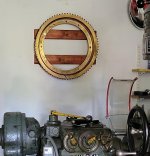Greg Menke
Diamond
- Joined
- Feb 22, 2004
- Location
- Baltimore, MD, USA
Hi all,
A good friend of mine is an elevator helper, working towards being a mechanic- he's in the middle of a job replacing a bank of vintage elevator equipment with new. He hooked me up with this worm gear wheel from one of the drives;
Bronze, very well over 100 lbs- gorgeous; just under 2' diameter, 1 tooth per inch, only mild wear. I'd love to have the matching worm but its deep in the casting on a long drive shaft- and he worked pretty hard to get this. OTOH he included a set of fancy bolts with ground shanks making a very nice fit used to attach it. I didn't use them for the wall mount because of the length and threads etc- and this system was easier.


So its a trophy on the wall now instead of in the scrap yard.
A good friend of mine is an elevator helper, working towards being a mechanic- he's in the middle of a job replacing a bank of vintage elevator equipment with new. He hooked me up with this worm gear wheel from one of the drives;
Bronze, very well over 100 lbs- gorgeous; just under 2' diameter, 1 tooth per inch, only mild wear. I'd love to have the matching worm but its deep in the casting on a long drive shaft- and he worked pretty hard to get this. OTOH he included a set of fancy bolts with ground shanks making a very nice fit used to attach it. I didn't use them for the wall mount because of the length and threads etc- and this system was easier.


So its a trophy on the wall now instead of in the scrap yard.
Last edited:



